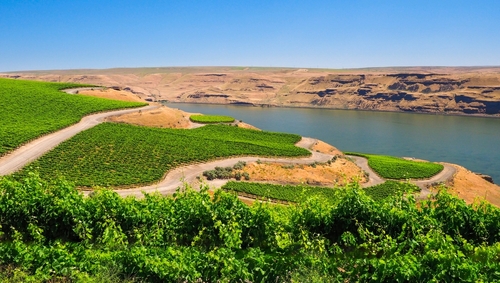By: Leah Gerber | Turning Point Strategic Advisors
What Happened (Announcement vs. Impact Timeline)
Summer 2023: Ste. Michelle Wine Estates (“SMWE”) told growers it would cut contracts by ~40% (grower meetings in July, reported publicly Aug 3 by Northwest Wine Report and Aug 9 by OPB).
Harvest 2023: Announcement in July formalized ongoing reductions many growers were already experiencing; some contracts already reduced going into 2023 season.
Harvest 2024: First full cycle under the cuts. WA harvest dropped to 150,000 tons (down ~6% YoY, per WA Wine Commission/USDA report published Mar 2025). Growers adjusted, but tanks remained full.
Harvest 2025 (Now): The second cycle without those contracts is when the cash crunch hits. Whites are picked, reds mid-harvest. Fruit being dropped financial distress becoming visible. Bud break in 2025 came in at almost exactly the historical average, but was followed by a drought declaration affecting much of Washington wine country in the Yakima Valley and Mid-Columbia (Tri-Cities Business Journal, June 2025).
Looking ahead: Bulk wine overhang will likely depress pricing for 2-3 vintages as the market works through excess inventory from the 2022-2023 oversupply years.
Working Estimates: Revenue Loss
Framed by harvest year:
- 2023: Partial effect (cuts announced late; <$15M impact)
- 2024: First full cycle, but some fruit absorbed via bulk channels; overall impact less visible
- 2025: Current harvest—full ~40% displacement → $30-49M estimated lost grower revenue
- 2026+: Continued pressure through lower bulk prices and tax receipts as 2025 wines would normally hit distribution
Pricing Benchmarks (2024 WA Wine Commission Data)
- Average across all varieties: $1,621/ton (WA Wine Commission, Mar 2025)
- Merlot (highest): $2,595/ton (WA Wine Commission, Mar 2025)
- Revenue calculation range: $1,300/ton (bulk/whites) to $1,750/ton (premium mix)
Displaced tonnage estimate: 23,000-28,000 tons with no buyer in 2025
Calculation methodology: SMWE historically contracted ~28,000 acres in recent years (down from 35,000 in 2017). A 40% reduction would impact ~11,200 acres. At Washington’s average yield of approximately 2.1-2.5 tons/acre, this represents 22,700-28,000 tons of displaced fruit. Not all will go unharvested (some found alternative buyers), but market feedback suggests 23,000-28,000 tons had no committed buyer as of September 2025.
Tax & Assessment Impact: Who Gets Hit
State Excise Tax Revenue (LCB)
The impact of lower WA grape harvests on LCB excise tax collections depends on how open consumers are to substituting wines produced outside the state. If demand remains steady and consumers are not brand-sensitive, there will be little variance in overall tax collection trends.
Working estimates from industry analysis:
- Total wine tax revenue: FY2022: ~$26.6M → FY2025: ~$24.4M (-8.1%)
- WA wine production (liters): FY2022: 26.1M → FY2025: 20.2M (-22.7%)
Key insight: Despite an estimated 22.7% drop in WA wine production, total wine tax revenue appears to have fallen only approximately 8.1% because consumers are substituting with imported wine. The LCB collects the same $0.2292/L excise tax (WA DOR Tax Reference Manual) whether wine is made in Washington or California—so state tax revenue remains relatively stable.
Methodology note: LCB does not publish detailed wine tax revenue data by fiscal year. These figures are working estimates derived from: (1) WA Wine Commission production data converted to liters; (2) statutory $0.2292/L excise tax rate; (3) industry observations that total wine sales in WA have remained relatively stable despite production declines; (4) economic logic that consumer substitution would moderate tax revenue declines. Actual figures may vary but the directional trend—modest tax decline despite sharp production decline—is consistent with observed consumer behavior.
Washington Wine Commission Assessment
The WWC is impacted more significantly because the $0.08/gallon producer’s assessment is ONLY collected on wines produced in Washington. WWC also collects a tonnage assessment directly from growers.
WWC Assessment Revenue Estimates:
- FY2022: ~$2.23M
- FY2023: ~$1.83M (-18.1%)
- FY2024: ~$1.74M (-4.7%)
- FY2025: ~$1.52M (-12.9%)
Estimated total decline: -32.0% from FY2022 to FY2025 = ~$715k lost annual revenue
This represents a significant impact to the Commission’s ability to fund marketing, research, and grower support programs.
Methodology note: WWC assessment revenue is not publicly itemized by fiscal year. These estimates are derived from: (1) WA Wine Commission production reports showing liter production by year; (2) statutory $0.08/gallon assessment rate on WA-produced wine; (3) estimated tonnage assessments based on reported harvest volumes; (4) reasonable assumption that assessment revenue would decline proportionally with production. The 32% decline from FY2022 to FY2025 mirrors the 37.5% production decline over the same period, adjusted for assessment collection timing lags.
Timing Note
We’re currently in October 2025 (FY2026). August tax filings were due Sept 20, and September filings haven’t occurred yet. Harvest timing varies year to year, so monthly tax data isn’t a reliable real-time indicator—the full impact shows up over the fiscal year as wine moves through distribution.
Where Things Stand (Early October, 2025)
Major issue right now: This is the second harvest where many growers can’t bridge the gap. Whites are already in tank, reds mid-harvest, but some fruit is being dropped. Tanks remain full from 2022-23, leaving limited outlet for displaced tonnage (industry reports, Sept-Oct 2025).
Note: While specific September 2025 OPB reporting has referenced dropped fruit and full tanks, formal harvest data and bankruptcy filings are not yet available. We’re relying on grower reports, industry conversations, and observable patterns from the 2024 harvest cycle to project 2025 outcomes.
Who’s Most Affected
- Growers >50% dependent on SMWE contracts, especially in Yakima/Columbia valleys, with Riesling and bulk Cabernet blocks most affected
- Small wineries that over-bought in 2024 and now sit on bulk inventory they can’t move
- Highly leveraged borrowers with lines of credit—in discussions with lenders as banks freeze LOCs and move accounts to special assets groups
What Needs to Happen NOW
Block-level cashflow triage: Evaluate crushing into bulk only if economics work, otherwise consider dropping fruit to minimize losses.
Lender engagement: This is an industry-wide transition, not a portfolio of bad loans. Banks should be requesting weekly or bi-weekly cashflow reports and monitoring harvest proceeds closely. However, lenders also need to prepare for constructive workouts—extending terms, restructuring debt, or converting to term loans where appropriate. The goal should be preserving viable operations through the downturn while managing exposure on fundamentally impaired credits.
Explore outlets: Distressed bulk sales, juice buyers, custom crush—though most are at capacity.
Immediate turnaround and restructuring options: Growers and wineries in distress should be exploring both short-term bridge solutions (harvest financing, emergency operating capital) and longer-term restructuring strategies (asset sales, partnership structures, operational consolidation). (A follow-up paper will detail specific turnaround strategies and restructuring frameworks.)
Impact on Distributors and Retailers
Distributors: Less supply from Ste. Michelle means fewer cases of branded WA wine in the pipeline, while oversupply elsewhere drives down bulk/bargain labels. Margin squeeze on mid-tier portfolios.
Retailers: National chains (Costco, Safeway) may see shifts in sourcing, with private labels blending distressed bulk. Boutique retailers may notice fewer WA SKUs or deeper discounts.
Downstream signal: Fewer premium WA placements + more bulk-driven blends erode brand equity, creating longer-term demand problems for the region.
Oregon Spillover
Oregon’s 129,739-ton 2024 harvest (Oregon Wine Board, June 2025) faces similar oversupply pressure, though less contract-driven. Displaced WA volume could still soften Oregon Pinot Noir and Chardonnay pricing in 2026.
Historical Precedent: Why 2013 Isn’t Comparable
The 2013 “Oversupply” — Growth, Not Contraction
In 2013, Washington harvested 210,000 tons of wine grapes, which was called a record at the time and created some inventory pressure (WA Wine Commission, 2015 Grape Crush Report). However, the industry response shows this was oversupply during expansion:
What happened after 2013:
- 2014: 227,000 tons (+4%) — new record (WA Wine Commission)
- 2015: 222,000 tons (-2%) — slight pullback
- 2016: 292,000 tons (+32%) — all-time record (Wine Spectator, Dec 2016)
- 2017: 227,000 tons
- 2018: 261,000 tons — second-largest ever (WA Wine Commission)
The pattern: After the 2013 “record,” growers planted MORE acres, and the industry crushed 29% more fruit just three years later. The market absorbed the 2013 supply, demand remained strong, and everyone kept planting. This was a natural growth cycle with temporary inventory pressure.
Today’s Situation: Structural Contraction (2022-2025)
The trajectory tells a different story:
- 2022: 240,000 tons — bounce-back from pandemic/smoke years (WA Wine Commission)
- 2023: 159,000 tons (-34%) — SMWE cuts announced (WA Wine Commission)
- 2024: 150,000 tons (-6%) — first full year of cuts (WA Wine Commission)
- 2025: Ongoing — second year under cuts, cash crunch intensifies
This is a 37.5% contraction in just two years (2022-2024), driven by:
- Structural demand destruction: Generational shift away from wine consumption
- Deliberate capacity reduction: SMWE’s 40% contract cuts (Northwest Wine Report, Aug 2023)
- No absorption capacity: Tanks full from 2022-2023, no bulk buyers stepping in (industry reports, Sept-Oct 2025)
Key difference: 2013 resolved through continued expansion. Today’s situation requires either demand recovery (unlikely in near term) or permanent industry right-sizing through vineyard removals, consolidation, and exits.
Industry Stress Indicators
National Context
Vintage Wine Estates (VWE): California-based producer filed Chapter 11 in July 2024 (WineBusiness, Reuters, July 24, 2024). VWE operated across over 30 wine and spirits brands and produced nearly 2 million cases annually, making it one of the larger U.S. wine companies. Their restructuring demonstrates how oversupply combined with soft consumer demand impacts even scaled operators.
In Washington
Distributor closures:
- Cru Selections (Woodinville) closed November 15, 2024 after 16 years, representing ~45 brands in WA and OR (Northwest Wine Report)
- Unique Wine Company (operating since 1981) closed in 2024 (Northwest Wine Report)
Winery and industry transitions:
- Multiple businesses in transition: Several Washington wineries and wine-related businesses have closed, announced equipment sales, or entered transition periods during 2024-2025, though not all details are public
- Hamilton Cellars (Red Mountain AVA) was put on the market for $3M in mid-2024 after the death of its founders, then sold to a Seattle-based property management company in April 2025. The company does not plan to operate a wine brand and is currently seeking a tenant to lease the winery and tasting room (Tri-Cities Business Journal, June 2025)
- Duckhorn Portfolio/Canvasback: Major national winemaker announced it would shut down its Washington state-based Canvasback label, the latest in a series of large wine companies struggling to find success in the state (Northwest Wine Report, May 2025)
- Ste. Michelle Wine Estates closed tasting rooms and wine clubs for two brands at end of 2024
Agricultural Credit Conditions
Recent ag lender surveys reveal changing conditions:
- 40% of lenders plan to tighten underwriting criteria for farmland loans through mid-2025 (ABA Banking Journal, Nov 2024)
- Over 50% plan to tighten standards for agricultural production loans (ABA Banking Journal, Nov 2024)
- Loan repayment rates below historical averages since Q4 2023 (Center for Commercial Agriculture, Feb 2025)
- Fund availability at ag banks decreasing since Q3 2022 (Center for Commercial Agriculture, Feb 2025)
- Lenders expect only 58% of borrowers will remain profitable in 2024, down from 78% in 2023 (ABA Banking Journal, Nov 2024)
Industry Sentiment and Market Headwinds
Silicon Valley Bank Wine Industry Sentiment Index stands at a 10-year low (SVB State of the U.S. Wine Industry 2025). Key concerns include:
- Generational shift: Wine-loving Baby Boomers becoming a smaller customer base; younger generations less inclined to drink wine
- National consumption decline: U.S. table wine consumption in 2023 reached its lowest level since 2011 at 759 million gallons (Wine Institute)
- Labor uncertainty: Talk of farmworker deportations by the Trump administration affecting labor sentiment (SVB Wine Industry Report 2025)
- Trade volatility: Rapidly shifting trade landscape and tariff-related lawsuits creating additional uncertainty (The Wine Economist)
- Health warnings: January 2025 U.S. Surgeon General warning linking alcohol to cancer risk and calling for new health labels may further impact consumption (HHS, Jan 2025)
Washington-specific challenge: “Washington wine’s single biggest problem is that most of its wines are produced in microscopic quantities and have little to no national presence. This has created a chicken-and-egg problem. The state can’t grow awareness without more people trying the wines, but people can’t try the wines because production is so small.” (Sean P. Sullivan, Northwest Wine Report, May 2025)
Sources Referenced
- Northwest Wine Report (Aug 3, 2023) — SMWE 40% cut announcement
- OPB (Aug 9, 2023) — SMWE contract cuts coverage
- KNKX (Aug 10, 2023) — SMWE “half the market” context
- WA Wine Commission/USDA (Mar 2025) — 2024 harvest 150k tons
- WA Wine Commission reports (2013-2024) — Historical harvest data
- Great Northwest Wine (Oct 2013) — 2013 harvest ~218k tons
- Wine Spectator (Dec 2016) — 2016 harvest 292k tons
- WA DOR Tax Reference Manual (2023) — Wine tax rate $0.2292/L
- RCW 66.24.210 — Excise timing (due on removals)
- Oregon Wine Board (June 2025) — 129,739 tons
- WineBusiness (July 24, 2024) — VWE bankruptcy
- Reuters (July 24, 2024) — VWE Chapter 11 coverage
- Northwest Wine Report (Nov 19, 2024) — Distributor consolidation (Cru Selections, Unique Wine Company closures)
- Tri-Cities Business Journal (June 2025) — Hamilton Cellars sale, Canvasback closure, 2025 drought, industry contraction
- Northwest Wine Report (May 2025) — Sean Sullivan on WA wine awareness problem, Canvasback closure
- SVB State of the U.S. Wine Industry Report (2025) — Industry sentiment index, labor concerns, market analysis
- Wine Institute (2023) — U.S. table wine consumption data
- The Wine Economist — Tariff impact analysis
- U.S. Department of Health and Human Services (Jan 2025) — Surgeon General alcohol-cancer warning
- ABA Banking Journal (Nov-Dec 2024) — Agricultural lender surveys
- Center for Commercial Agriculture (Feb 2025) — 2025 Ag Credit Outlook
Data Notes & Methodology
Harvest data sourced from WA Wine Commission annual production reports and USDA NASS. Tax data represents working estimates based on production volumes, statutory tax rates, and industry analysis, as LCB does not publish granular wine tax revenue data by fiscal year. Actual tax collections may vary from estimates presented here.
Revenue loss calculations based on estimated 23,000-28,000 tons of displaced fruit with no buyer in 2025 harvest, using 2024 pricing benchmarks adjusted for bulk/premium mix. Displacement calculation: SMWE’s ~28,000 contracted acres × 40% reduction × 2.1-2.5 tons/acre average yield = 22,700-28,000 tons. Actual impact will vary by grower contract structure and vineyard quality tier.
Fiscal year timing: Washington state fiscal year runs July 1 – June 30. FY2025 data (through June 30, 2025) reflects 2023 and 2024 harvests moving through the market. Impact of 2025 harvest will show in FY2026+ data.
Current conditions (Oct 2025): Formal harvest reports for 2025 are not yet available. Analysis relies on grower reports, industry conversations, observable market conditions, and patterns from the 2024 harvest cycle.


